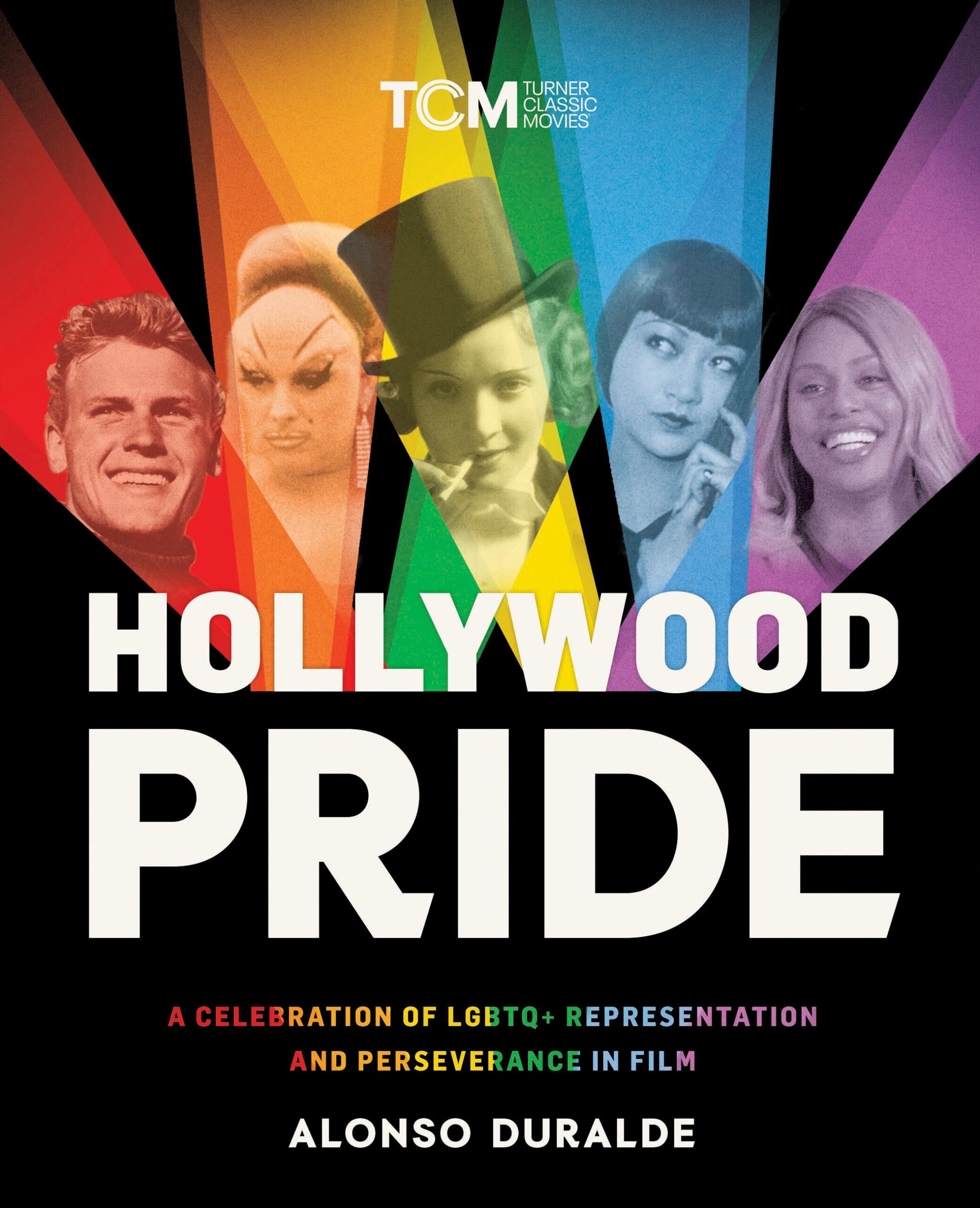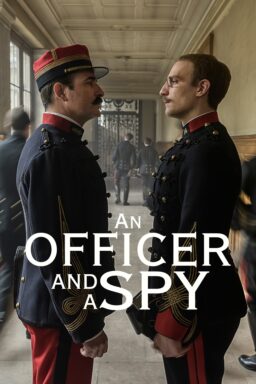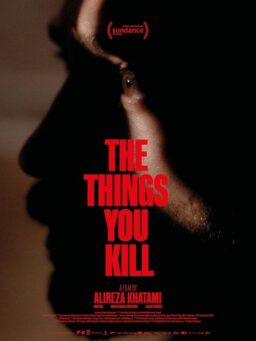We are proud to present an excerpt from Hollywood Pride by Alonso Duralde. In stores now or get your copy here. The official synopsis is below, followed by the excerpt.
For generations, members of the LGBTQ+ community in Hollywood needed to be discreet about their lives but—make no mistake—they were everywhere, both in front of and behind the camera.
On the eve of the twentieth century, in Thomas Edison’s laboratory, one of the earliest attempts at a sound film depicted two men dancing together as a third plays the violin. It’s only a few minutes long, but this cornerstone of early cinema captured a queer moment on film. It would not be the last.
With Hollywood Pride, renowned film critic Alonso Duralde presents a history spanning from the dawn of cinema through the “pansy craze” of the 1930s and the New Queer Cinema of the 1990s, all the way up to today. He showcases the hard-working actors, writers, directors, producers, cinematographers, art directors, and choreographers whose achievements defined the American film industry and charts the evolution of LGBTQ+ storytelling itself—the way mainstream Hollywood decided it would portray (or erase) their lives and the narratives created by queer filmmakers who fought to tell those stories themselves.
Along the way, readers will encounter a fascinating cast of characters, such as the first generation of queer actors, including J. Warren Kerrigan, Ramon Novarro, and William Haines. Early cinema pioneers like Alla Nazimova and F. W. Murnau helped shape the new medium of moving pictures. The sex symbols, both male (Rock Hudson, Tab Hunter, and Anthony Perkins) and female (Lizabeth Scott and Greta Garbo), lived under the threat of their private lives undermining their public personas. Underground filmmakers Kenneth Anger and John Waters made huge strides in LGBTQ+ representation with their off–off-Hollywood productions in the 1960s and ’70s. These screen legends paved the way for every openly queer figure in Hollywood today.
Illustrated with more than 175 full-color and black-and-white images, Hollywood Pride points to the bright future of LGBTQ+ representation in cinema by revealing the story of the community’s inclusion and erasure, its visibility and invisibility, and its triumphs and tragedies.
PANSIES BLOOM, EVEN IN THE DARK
The stock market crash of 1929 meant that the 1930s began with the Great Depression in full swing. That economic downturn benefited the motion-picture industry in a way; people were chasing inexpensive escapism, after all, and movie palaces remained relatively affordable and accessible. But in the way that all financial and natural disasters seem to do, the Depression brought out the moralists and the pearl-clutchers, railing about sin and claiming that the lusty excesses of the Roaring Twenties—including men questioning traditional modes of masculinity and modern women insisting on a greater degree of sexual agency—were the cause of the present misery.
To its credit, Hollywood held onto the freewheeling times longer than most—the early 1930s saw the “pansy craze” take hold in Los Angeles, as nightclubs with LGBTQ+ performers (and patrons) became hot spots and celebrity magnets. That these institutions were among the few still serving alcohol during the Prohibition era no doubt boosted their popularity. But even naughty old Tinseltown could buck gender conventions only so far; soon these clubs became the target of police raids, a new phenomenon that would continue for decades, most legendarily at New York’s Stonewall bar in 1969.
America’s rural areas and backroads experienced a boom for religious revivals, as tent shows popped up all over the country, with charismatic (in every sense of the word) preachers winning souls to the Lord—and filling up their collection plates in the process. If the movies didn’t necessarily find religion, they did find the Production Code, which provided a new set of rules that all studio productions would be forced to follow, making LGBTQ+ characters on-screen hard to find, if not downright invisible.
In Germany, the rise of the Nazis in 1933 spelled an end to the Weimar era and to any progress in the study of homosexuality—a band of students attacked Hirschfeld’s Institute of Sexual Research, and a later sweep thoroughly destroyed his entire library and archive. Germany’s Paragraph 175 law, which outlawed sexual relations between men, began to be enforced with efficiency and cruelty, with gay men being carted off to prison and then, within a few years, Hitler’s death camps. Not fully repealed until 1994, the continued enforcement of Paragraph 175 meant that when those camps were eventually liberated, the men with the pink triangles were the only captives sent back to prison, rather than being set free.
What was historically the worst of times in many ways was, conversely, a golden age for the Hollywood studio system, even if LGBTQ+ artists had to live their lives off-screen with discreet circumspection while queer characters in movies could be found only if you looked at the screen at just the right angle.
THE PRODUCTION CODE
The establishment of the Motion Picture Production Code was, like so many of the big decisions made by Hollywood studios, partially about money, partially about performative morality, and partially about taking control of a situation before any outsiders could.
Specifically, the Code was put in place to ward off threatened boycotts by the Catholic Church and other nationwide organizations, and also to quash local censors who were taking the scissors to movies, based on local standards that varied from community to community. Also, by the late 1920s, most of the studios were also getting into the theater business, buying up screens and merging with exhibitors, and the influx of Wall Street cash meant demands for conservative business practices.
The first attempt at instituting a Code came in 1922, when the studios brought former postmaster Will Hays to Hollywood. As historians Leonard J. Leff and Jerold L. Simmons put it: “An ex-Republican national chairman with White House connections, Hays was a booster straight out of Babbitt. He was an elder of the Presbyterian Church and had a shrill voice that could assume an evangelical roar.” With the help of Jason Joy, late of the War Department, Hays put together a list of “Don’ts and Be Carefuls,” which studios—reliant upon sex and violence to sell tickets—at first ignored.
But as outside pressures mounted, the Hays office brought on a battler, Joe Breen, who skillfully threaded the needle between the studios’ needs and the censors’ desires, and with input from Motion Picture Herald publisher Martin Quigley—who helped run interference with Catholic higher-ups—the Code was born. First signed by the studio heads in 1930, it was locked firmly in place by 1934, with most theater chains rejecting any film that didn’t come with the seal of approval.
One overlap between the “Don’ts and Be Carefuls” list and the Code itself was an absolute ban on “sex perversion,” which essentially erased all LGBTQ+ characters and themes from Hollywood movies from the early 1930s until the Code was abolished in the 1960s. Worse still, stars were expected to be as wholesome as the movies they made, with morality clauses in contracts and marriages of convenience suddenly the order of the day for queer performers and directors.
“Desperate to avoid scandal, producers insisted that publicists turn the stars into ‘wholesome Americans,’” wrote William J. Mann. “No more photographs of women in pants. No more cohabiting without benefit of marriage.”
Still, at the movies, queerness itself wasn’t completely eradicated; Leff and Simmons quote a scenarist who said that the Code “forced writers not only to be cleaner but also to be cleverer.” In the documentary The Celluloid Closet, screenwriter Jay Presson Allen (Cabaret) agreed, noting, “You know, the guys who ran that Code weren’t rocket scientists. They missed a lot of stuff. And if a director was subtle enough and clever enough, they got around it.”
In this chapter and over the next few decades, we’ll look at the films that “got around it.”
WHO WEARS THE PANTS
Morocco (1930)
Written by Jules Furthman, from the play Amy Jolly by Benno Vigny. Directed by Joseph von Sternberg.
Queen Christina (1933)
Written by H. M. Harwood and Salka Viertel, from a story by Viertel and Margaret P. Levino; dialogue by S. N. Behrman. Directed by Rouben Mamoulian.
Throughout the nineteenth century, and even into the first half of the twentieth century, various municipalities in the United States passed laws forbidding women to wear trousers, part of an overall effort to enforce gender norms. So it was no small thing when two of the screen’s most glamorous love goddesses decided to throw on a pair of pants.
In Morocco, Marlene Dietrich’s Amy Jolly wears a number of sexy Travis Banton creations, but perhaps her most memorable outfit is the tuxedo she dons for one of her nightclub performances. She flirts with a female patron and then kisses her, and though it’s all in the service of Dietrich’s seduction of Gary Cooper’s legionnaire, the outfit—and that kiss—permanently cemented Dietrich’s status as an icon for lesbian audiences.
Three years later, in the title role of Queen Christina, Greta Garbo took masculine gender expression even further, mixing her standard ravishing hair and makeup with trousers and suits. When a courtier tells the monarch, “You cannot die an old maid,” she responds, “I have no intention to, Chancellor. I shall die a bachelor.” The ahistorical film invents a heterosexual romance for this historical figure: The real Queen Christina was devoted to her friend and “bedfellow” Ebba Sparre. The film’s Ebba, played by Elizabeth Young, gets to share a few kisses with Christina, but both are depicted as being in love with men.
Excerpted from HOLLYWOOD PRIDE: A Celebration of LGBTQ+ Representation and Perseverance in Film by Alonso Duralde. Copyright © 2024. Available from Running Press, an imprint of Hachette Book Group, Inc.











